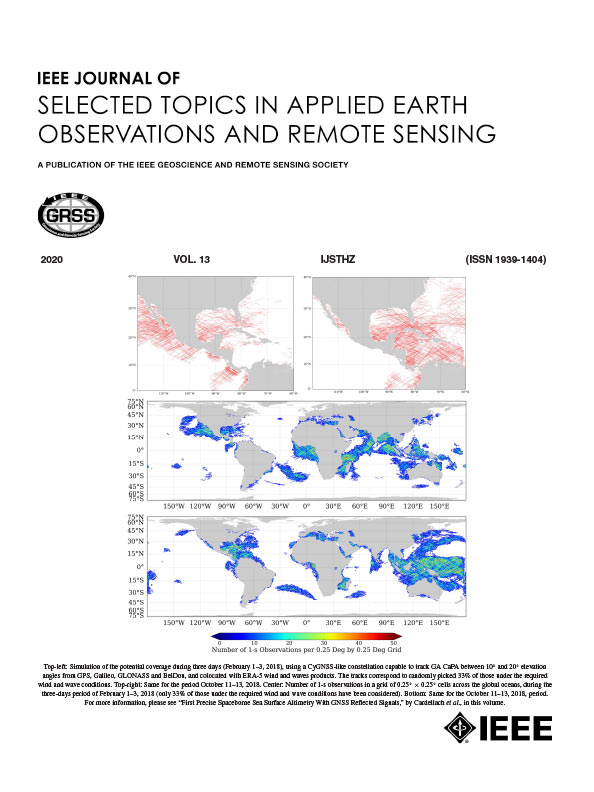ICESat-2 Satellite LiDAR Bathymetry Extraction Algorithm Based on Cubic Function Fitting Prediction Interval Along Track Segments
IF 5.3
2区 地球科学
Q1 ENGINEERING, ELECTRICAL & ELECTRONIC
IEEE Journal of Selected Topics in Applied Earth Observations and Remote Sensing
Pub Date : 2025-07-01
DOI:10.1109/JSTARS.2025.3584760
引用次数: 0
Abstract
The 532-nm laser pulses emitted by the Ice, Cloud, and Land Elevation Satellite-2 (ICESat-2) demonstrate significant potential for shallow water depth measurement. However, due to factors such as atmospheric scattering and absorption, and solar background noise, ICESat-2 data inevitably contains many noise photons. Based on the continuously changing characteristics of the seafloor topography, this article proposes an ICESat-2 bathymetry extraction algorithm based on cubic function fitting prediction interval along track segments. The key step of this algorithm is that the underwater photons are selected using the range of the mean plus or minus five times the standard deviation of the Gaussian function fitted of the photon height histogram, after which cubic function fitting is performed. When the coefficient of determination (基于轨迹段三次函数拟合预测区间的ICESat-2卫星激光雷达测深提取算法
冰、云和陆地高程卫星2号(ICESat-2)发射的532纳米激光脉冲显示了浅水深度测量的巨大潜力。然而,由于大气散射和吸收、太阳背景噪声等因素的影响,ICESat-2数据不可避免地包含了许多噪声光子。基于海底地形的连续变化特征,提出了一种基于三次函数拟合预测区间的ICESat-2测深提取算法。该算法的关键步骤是利用光子高度直方图拟合的高斯函数的平均值正负5倍标准差的范围来选择水下光子,然后进行三次函数拟合。当拟合的决定系数(R2)大于阈值时,使用95%的预测区间进行去噪;如果小于阈值,则使用直方图的高斯函数拟合进行去噪。选择五个研究领域进行相关实验。分别用现场测深数据和人工提取的信号光子对去噪结果进行了评价。结果表明:ICESat-2测深数据与原位测深数据呈现高度一致的趋势,R2均大于0.97,RMSE均小于0.5 m;基于人工选择的信号光子计算的评价指标均超过93%,F1得分在96%以上。与自适应高程差阈值分割算法、基于密度的含噪声空间聚类应用、排序点识别聚类结构等算法相比,本文算法的去噪效果最好,提取的海底光子具有良好的连续性,无明显的噪声光子。
本文章由计算机程序翻译,如有差异,请以英文原文为准。
求助全文
约1分钟内获得全文
求助全文
来源期刊
CiteScore
9.30
自引率
10.90%
发文量
563
审稿时长
4.7 months
期刊介绍:
The IEEE Journal of Selected Topics in Applied Earth Observations and Remote Sensing addresses the growing field of applications in Earth observations and remote sensing, and also provides a venue for the rapidly expanding special issues that are being sponsored by the IEEE Geosciences and Remote Sensing Society. The journal draws upon the experience of the highly successful “IEEE Transactions on Geoscience and Remote Sensing” and provide a complementary medium for the wide range of topics in applied earth observations. The ‘Applications’ areas encompasses the societal benefit areas of the Global Earth Observations Systems of Systems (GEOSS) program. Through deliberations over two years, ministers from 50 countries agreed to identify nine areas where Earth observation could positively impact the quality of life and health of their respective countries. Some of these are areas not traditionally addressed in the IEEE context. These include biodiversity, health and climate. Yet it is the skill sets of IEEE members, in areas such as observations, communications, computers, signal processing, standards and ocean engineering, that form the technical underpinnings of GEOSS. Thus, the Journal attracts a broad range of interests that serves both present members in new ways and expands the IEEE visibility into new areas.

 求助内容:
求助内容: 应助结果提醒方式:
应助结果提醒方式:


